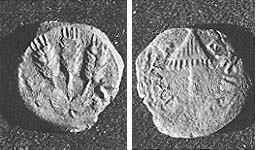Image Details

Mrs. H. Solomon
First century A.D. grave coin: This coin was found inside a skull at the Jericho cemetery. Coins were often placed on the eyes of the deceased—a vestige of a pagan custom to pay Charon, the guardian of the river leading to the land of the dead. On one side of the coin is a canopy with a Greek inscription Basileus Agrippa, which means “Ruler Agrippa.” This refers to the grandson of Herod the Great, Herod Agrippa I, who ruled the Judean province from 41–44 A.D. Three barley stalks sprouting from two leaves decorate the other side of the coin, and the date LS 6, or year six of Herod’s reign, is inscribed under the leaves on its outer rim. Throughout the Roman Empire, pagan symbols of the Empire and the Emperor’s face were imprinted on coins. However, in deference to Jewish laws prohibiting representation of human figures in any craft or art, the Romans did not use pagan symbols or portraits on coins circulated in the Judean province.
